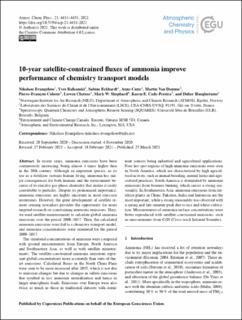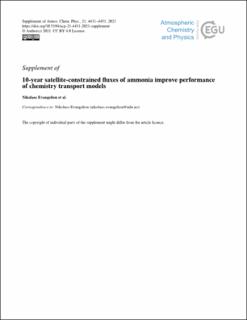| dc.description.abstract | In recent years, ammonia emissions have been continuously increasing, being almost 4 times higher than in the 20th century. Although an important species, as its use as a fertilizer sustains human living, ammonia has major consequences for both humans and the environment because of its reactive gas-phase chemistry that makes it easily convertible to particles. Despite its pronounced importance, ammonia emissions are highly uncertain in most emission inventories. However, the great development of satellite remote sensing nowadays provides the opportunity for more targeted research on constraining ammonia emissions. Here, we used satellite measurements to calculate global ammonia emissions over the period 2008–2017. Then, the calculated ammonia emissions were fed to a chemistry transport model, and ammonia concentrations were simulated for the period 2008–2017. The simulated concentrations of ammonia were compared with ground measurements from Europe, North America and Southeastern Asia, as well as with satellite measurements. The satellite-constrained ammonia emissions represent global concentrations more accurately than state-of-the-art emissions. Calculated fluxes in the North China Plain were seen to be more increased after 2015, which is not due to emission changes but due to changes in sulfate emissions that resulted in less ammonia neutralization and hence in larger atmospheric loads. Emissions over Europe were also twice as much as those in traditional datasets with dominant sources being industrial and agricultural applications. Four hot-spot regions of high ammonia emissions were seen in North America, which are characterized by high agricultural activity, such as animal breeding, animal farms and agricultural practices. South America is dominated by ammonia emissions from biomass burning, which causes a strong seasonality. In Southeastern Asia, ammonia emissions from fertilizer plants in China, Pakistan, India and Indonesia are the most important, while a strong seasonality was observed with a spring and late summer peak due to rice and wheat cultivation. Measurements of ammonia surface concentrations were better reproduced with satellite-constrained emissions, such as measurements from CrIS (Cross-track Infrared Sounder). | en_US |


